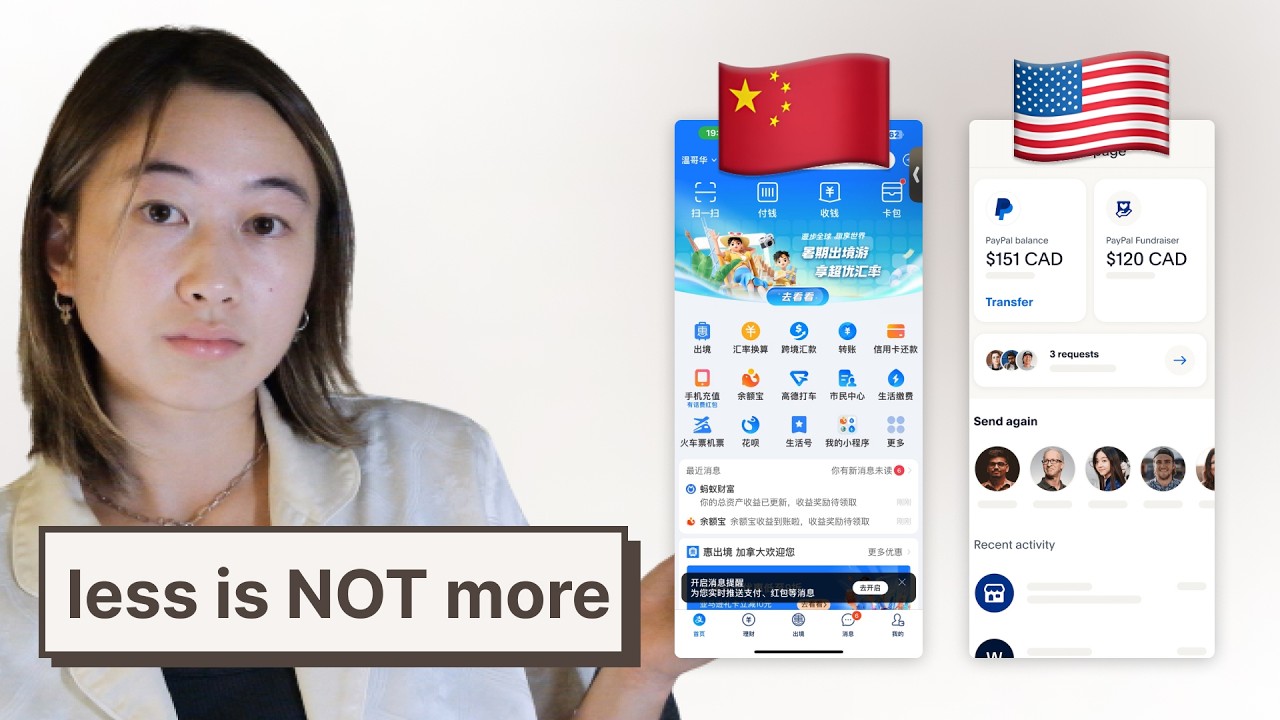- cross-posted to:
- socialism@lemmy.ml
- technology@lemmygrad.ml
- technology@lemmy.ml
- cross-posted to:
- socialism@lemmy.ml
- technology@lemmygrad.ml
- technology@lemmy.ml
I’m going to use this video as a reference for my own website project.
What do you all think?
It seems that Japanese and Chinese website design is just superior to Western design.
The comments are bad as usual haha



Super scattered thoughts incoming
Guess it depends on your target audience, the best app is the one that your users want to use (or have to use if you’re into that kind of thing).
I wish the video had some specific walkthroughs of using multiple large features in a super app, like the super app version of their example of opening 4+ apps to get a friends coffee. Is it faster / more seamless? I don’t doubt that it is or could be, I just haven’t used any of the super apps.
Feels like a vim vs emacs situation. I love vim, it’s fast and has all the text editing tools I need, but emacs ships with an irc client and tetris which is dope.
Modern American app and web design is surprisingly meh. The ideal is nice (responsive to various screen sizes, accessible) , but most sites fail all over the place (I’ve never worked with anyone who knows accessibility well, myself included). Plus, there is so much dead, empty space on desktop sites. Not sure that hyper cluttered would be good for new users or my ADHD, but I can see the appeal.
Good luck with your project! Mind if I ask what it is?
Something that people yake for granted is that while some UI patterns are more intuitive and sensible than others, the larger picture which is formed when countless such patterns are stiched together usually relies on cultural inertia to be generally accessible. Some softwares are revolutionary in their design but most have to stick within a narrow window of what other popular softwares are doing. GNOME and KDE for example took a lot of cues from Windows and Mac were doing over the years. This is mostly because Microshit and Apple are monopolistic companies with a deep market reach and deviating drastically from the norms set by them would dissuade a lot of potential newcomers.
China’s stuff–websites and apps–looks different because they were not tethered to norms set by the Western tech industries since they did not or could not cater to the Chinese market. I don’t mean to say it is better or worse because of that. But it’s good that this variety exists.
Totally agreed about that. It’s called the Principle of Least Surprise for a reason. Users don’t want to learn your software, they just want to achieve their goal in an easy way. Inertia and convention guide all that.
true 'nuff
Frankly, that’s what I want from my websites: variety.
I can give you an IRL example. On AlipayHK (Hong Kong has a unique version of the app) there’s a sub-app called ‘cross-border zone’. If I open that, it turns out it’s a collection of other sub-apps all related to making visits to the mainland from Hong Kong. There’s a train booking app, a ride share app specifically for cross-border trips (which specifically requires cars that have dual license plates), a hotel booking app, Klook (a ticket booking app for attractions on either side of the border), and even a dental appointment booker (Mainland dentists are cheaper and don’t try to scam you, so they get a lot of business from Hong Kongers).
The dental appoinment booker is essentially a directory of dental clinic ads.
If I wanted to spend Firday night in Shenzhen and get my teeth cleaned in the morning, I can do all the planning and booking through Alipay sub-apps, with varying degrees of integration. The dental booking one opens individual clinic websites in an in-app browser that has standard buttons at the bottom to have the clinic I’m looking at either text me or call me. The ride share app is as full-fledged as Uber.
Everything will have been vetted with Alipay, so the different apps can get data (and obviously payment) from the platform and there’s nigh zero form-filling for each service even if I’ve never used them before. The video talks about clutter design giving reassurance by giving more information, but there’s more reassurance (IMO) in the knowledge that by encapsulating these apps, Alipay is essentially vouching for them.
And the kicker is: the service Alipay provides is free for us as users. They don’t charge transaction fees, even when exchanging currencies. Alipay makes money by having the businesses pay to be on the app. Apart from the core infrastructure and government services, the sub apps pay to be sub apps. And below the list of popular sub-apps on the front page, there’s reams and reams of ‘coupons’. Businesses pay Alipay to offer you discount coupons for their products and services.
I need to say something for the ads on super apps like Alipay. It’s a weird experience. It’s viscerally different from ads on, say, Google. On Google, you’re the product. Businesses pay to place themselves at the top of the search results. You don’t benefit from that in any way: the price for your search results is that the top results aren’t the best results for you but the best results for Google and its customers.
On Alipay, the payment platform stuff is at the top, followed by the sub-apps, and then the ads infinite-scroll underneath. There’s no ads on top like on Google, there’s no full-screen ad or video that you have to wait 15 seconds to skip. The ads are skipped by default, and those ads have to offer some additional motivation for you to choose to scroll through them. So all the ads are coupons. There’s just thousands and thousands of discount deals, and you tap on them to ‘claim’ the coupon, and in most cases Alipay automatically applies the discount within its payment system. You’re still the product, but you opt-in, and you get a cut.
I swear Alipay is a manifest rebuttal to the accusation that China is capitalist. It superficially looks capitalism-dystopian as fuck when you look at the UI, but the experience of using it is experiencing a system that serves public interests instead of corporate interests.
That’s so interesting! Thanks so much for all the context and screenshots.
That does seem appealing, especially with the alternative being to Google for details and hope the reviews you find are legit/not bought.
It’s really interesting that they aren’t trying to make both the end user and subapp company pay to interact, that’s refreshing.
I wrote out a whole thing/rant about how providing core services to the people and market all seem like a no brainer, but it got a bit convoluted. Long story short, this all looks pretty interesting, I’ll definitely check it out more.
Last thing, having ads you opt in to see, that are worth looking for, seems so nice. Everything is an ad now, where it’s google or any other generic product review site. It’s exhausting having to determine if any info you find online is legit enough to be useful.
I want to make a neocities website and, for now, that may be about it (again, for now).
But I have a few “project ideas” that, honestly, I’m torn on what to do first.
The “project” is basically to make my first website… and to make it USEFUL. Like, what do people need right now? What do communists need? Or organizers? Or different leftists? What would someone genuinely like?
And what hasn’t been done before?
dead empty space is literally settler culture.
things that immediately jump to me that are very western are lawns, parking lots, suburbs and now app design.
Lawns are the Devil.
Lawns make suburbs especially virtually unwalkable because everything is so far away from each other…